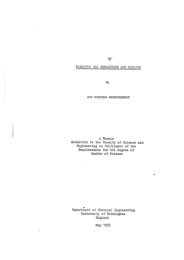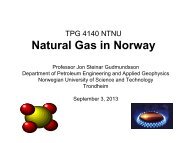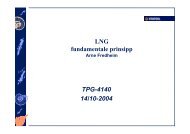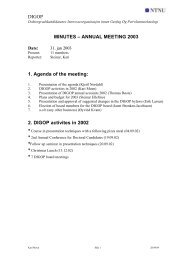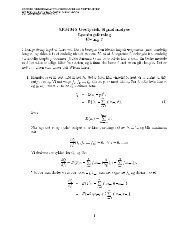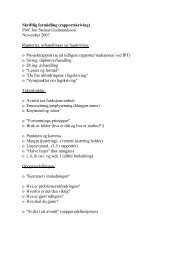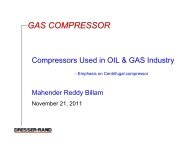Slug Catchers in Natural Gas Production - NTNU
Slug Catchers in Natural Gas Production - NTNU
Slug Catchers in Natural Gas Production - NTNU
You also want an ePaper? Increase the reach of your titles
YUMPU automatically turns print PDFs into web optimized ePapers that Google loves.
Karam – <strong>Slug</strong> <strong>Catchers</strong> <strong>in</strong> <strong>Natural</strong> <strong>Gas</strong> <strong>Production</strong><br />
the slug and film length and zone are shown <strong>in</strong> Figures 4 and 5. The film length of the slug and the<br />
slug length for a hydrodynamic flow are represented, respectively, as follows,<br />
( ) (9)<br />
( )<br />
(10)<br />
The slug frequency denot<strong>in</strong>g the rate of <strong>in</strong>termittence of the slug through the pipel<strong>in</strong>e, is expressed as<br />
(11)<br />
with L U , the slug unit length, be<strong>in</strong>g the sum of the slug length L S and the film length L L .<br />
The <strong>in</strong>stantaneous <strong>in</strong>let flow rates of both gas and liquid are important slug characterization features<br />
and crucial for the design of the slug catchers. These rates have been calculated by us<strong>in</strong>g the Miyoshi<br />
et al model (1988). The equations are as follow:<br />
- for the liquid: (12.a)<br />
- for the gas: (12.b)<br />
The liquid accumulation <strong>in</strong> the slug catcher should be determ<strong>in</strong>ed <strong>in</strong> order to def<strong>in</strong>e the size of the slug<br />
catcher. Accord<strong>in</strong>g to Sarica et al. (1990), a mass balance between the <strong>in</strong>let and outlet liquid rate of the<br />
slug catcher can be used to calculate the accumulated liquid rate and thus the accumulated liquid<br />
volume.<br />
[ ] [ ] [ ]<br />
To solve the mass balance, the different parts of the equation should be determ<strong>in</strong>ed separately. As<br />
expressed earlier, the liquid <strong>in</strong>put mass rate can be calculated with the Miyoshi et al. (1998) model<br />
similarly to equation (12.a). The liquid discharge mass rate represents the flow rate at the outlet of the<br />
slug catcher which is, <strong>in</strong> turn, dependent upon the flow control valve (Marquez et al., 2009). The<br />
liquid accumulation rate can be calculated from equation (13) with the assumption of a constant liquid<br />
density <strong>in</strong> the slug catcher and no acceleration while slug production (Sarica et al., 1990). On the other<br />
Page 14 of 56



